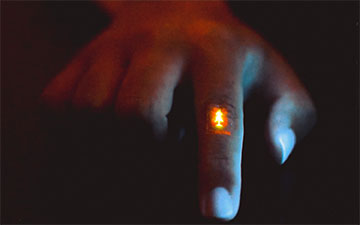
A sample of flexible light-emitting film, displaying the Stanford University logo, on the knuckle of a finger shows how the film can hold up to flexing and wrinkling. [Image: Z. Zhang and J. Lai, Bao Group Research Lab]
Today’s implantable or wearable electronics are made of silicon and inorganic semiconductors, which are inherently rigid materials that provide a less-than-ideal interface with skin and biological tissue. A significant challenge for the next generation of devices will be to preserve performance while adding mechanical flexibility to better maintain contact and minimize discomfort.
Now, researchers from the United States and China have developed high-brightness light-emitting diodes (LEDs) that can stretch, bend and flex (Nature, doi: 10.1038/s41586-022-04400-1). The novel LEDs, which were used to create a pliable, patterned light-emitting film, may provide a foundation for next-generation digital displays that can be worn directly on the skin.
Creating an all-polymer LED
Organic LEDs (OLEDs), which are widely employed in modern television screens and computer monitors, can be made flexible by depositing the electroluminescent organic semiconductor on a plastic substrate. However, digital displays with repeatable stretchability and low stiffness have remained elusive. Approaches thus far have failed to demonstrate sufficient levels of device performance, stretchability or resolution.
For example, previous work has explored the idea of all-polymer LEDs (APLEDs), but most light-emitting polymers are brittle and crack when stretched. About three years ago, Zhitao Zhang discovered that mixing certain light-emitting polymers—including one called SuperYellow—with polyurethane led to a soft and pliable APLED that could still achieve high brightness.
“If we add polyurethane, we see SuperYellow form nanostructures,” said Zhang, a postdoctoral scholar at Stanford University, USA, in a press release accompanying the research. “These nanostructures are really important. They make the brittle polymer stretchable, and they make the polymer emit brighter light because the nanostructures are connected like a fishnet.”
The nanoconfined light-emitting polymer structures are formed by spontaneous phase separation that occurs when SuperYellow is blended with polyurethane. The resulting fishnet architecture enhanced, instead of inhibiting, charge transport.
Seamless integration with the skin
Along with a yellow light-emitting layer, the researchers used the same principle to create elastic red, green and blue light-emitting layers. They then fabricated high-performance stretchable APLEDs with maximum brightness of 7450 candela per square meter at 15 V. The corresponding maximum current efficiency was roughly 5.3 candela per ampere. In addition, the APLED could be stretched to twice its original length while maintaining its uniformity and bright light emission.
Lastly, the researchers built a patterned light-emitting film with the APLEDs that seamlessly integrated with the skin through a wireless energy-harvesting system. As a demonstration, the device was able to display real-time pulse signals of a human user by blinking.
“Stretchable displays can allow a new way of interactive human-machine interface,” said senior study author Zhenan Bao, an engineering professor at Stanford University, in a press release accompanying the research. “We can see the image and interact with it, and then the display can change according to our response.”
